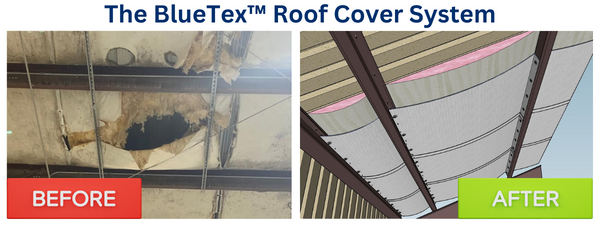Can I Install BlueTex™ Insulation on the Roof Portion Only?
Absolutely! Many customers opt to install BlueTex™ metal building insulation on the roof portion only, and it's a great option, especially if your main goal is to control condensation.
Why Focus on the Roof First?
Condensation tends to form primarily on the roof of a metal building, though you can find condensation on the walls too. Condensation forms due to the temperature differences between the outside and the inside of the building. When warm, moist air comes into contact with a cool roof surface, condensation occurs. By installing BlueTex™ on the roof, you're addressing the main area where moisture can accumulate. BlueTex™ helps to keep the roof relatively warmer than the metal without BlueTex™ and this helps reduce the chance of moisture forming. The BlueTex™ 6mm Supreme is the best product for moisture control, so we recommend that for a roof-only application.
Benefits of Roof-Only Installation:
- Condensation Control: Since the roof is the primary area where condensation forms, insulating it can significantly reduce moisture buildup. This is especially important in metal buildings, carports, and garages where condensation can cause rust or damage.
- Instant Shade: Insulating your roof with BlueTex™ also helps to create an “instant shade” effect, significantly reducing heat gain during hot summer months because of the radiant barrier layer. You’ll notice cooler temperatures inside, even without cooling equipment, making the space more comfortable to use.
- Efficient for Non-Conditioned Spaces: If your building is rarely or never heated or cooled, focusing on the roofline is an efficient solution to cut back on the heat gain. You'll get the most benefit from reduced heat transfer without the need to fully insulate the entire structure.
When to Consider Fully Insulating
If you plan on regularly heating or cooling your building (creating an office space, an apartment, or a full-time home), insulating your building with radiant barrier and R-value insulation is usually the best choice. For these applications you should plan to insulate both the walls and the roofline for maximum comfort and efficiency. We cover the basics of this type of application here: Insulating a Fully Conditioned Building.
However, for many carports, garages, or outbuildings that are used for storage or occasional work, roof-only insulation provides a practical and cost-effective solution. Remember, non-conditioned buildings don't need R-value to feel more comfortable.
In conclusion, installing BlueTex™ insulation on the roof portion only is an excellent way to control condensation and reduce heat gain, especially in spaces that aren’t regularly climate-controlled. It's a simple, effective solution to improve the comfort and longevity of your structure!





